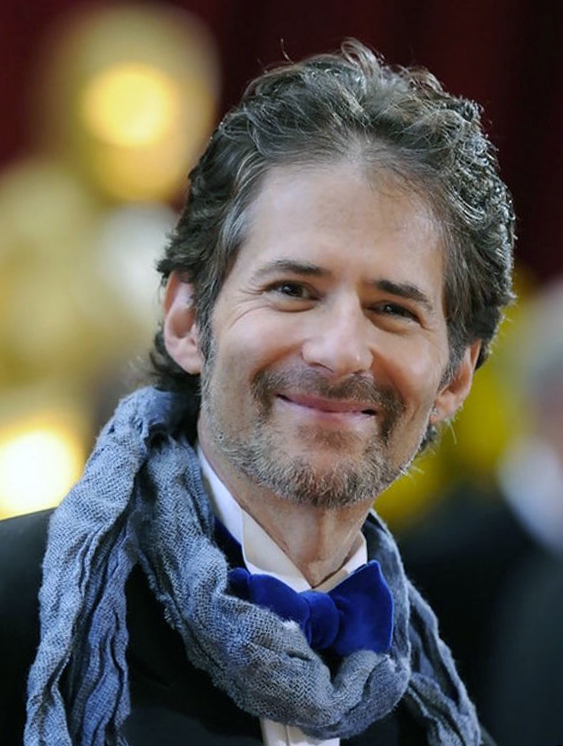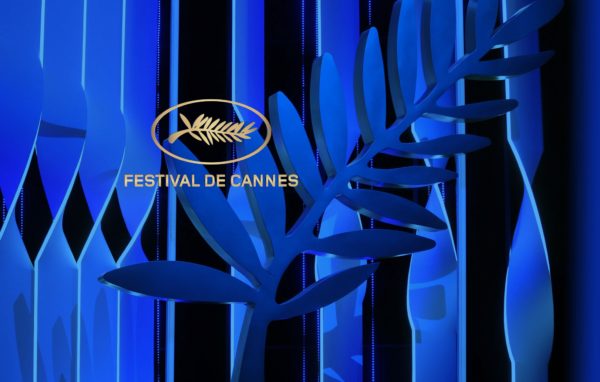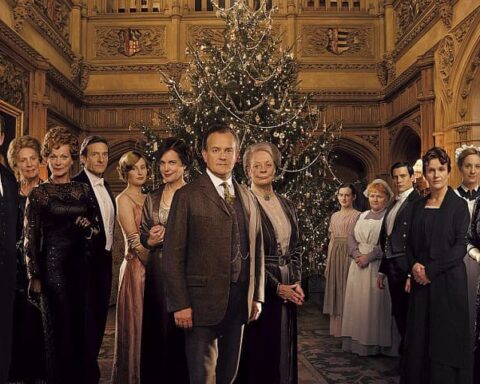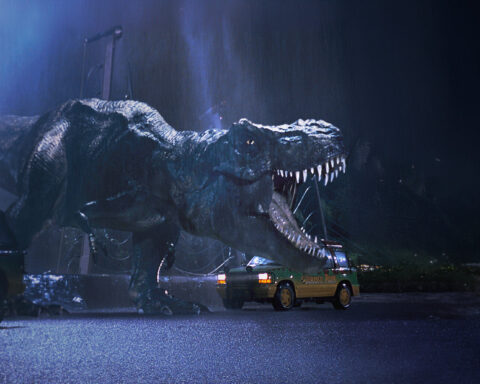There is a piece of film music that is played twice every year at the Cannes Film Festival: during the opening and closing ceremonies. Evoking childhood memories, it is the work of prolific composer James Horner, who passed away in June 2015 and also composed the soundtrack for Titanic. Less well known for its connection to the festival than Camille Saint Saens’ “The Carnival of the Animals,” which precedes each screening, “The Land Before Time” is nevertheless one of James Horner’s most accomplished works.
The French pianist Camille Saint Saëns, with his work Le Carnaval des Animaux, is the eminent representative of classical music at the Cannes Film Festival, introducing each screening since the 1990s. James Horner, meanwhile, is responsible for representing film music but also for opening and closing the festival each year with music.
The score, written for the animated children’s film The Land Before Time by Don Bluth (1988), produced by Steven Spielberg, has all the hallmarks of a work for adults. An embodiment of emotional gigantism, this ode to maternal love oscillates between drama and optimism and carries within it the courage to carry on despite adversity. It is, in short, a metaphor for the creative act and, even more so, for life itself.
A project bigger than life
Long before the success of Braveheart, Titanic, and Avatar, James Horner made a name for himself by incorporating choirs and electronic elements into his classical orchestrations.
With an impressive knowledge of the classical repertoire, he was recognized and sometimes criticized for his “free associations,” which bordered on plagiarism. He even went to court over the music for Honey, I Shrunk the Kids, which was attacked by the heirs of Italian composer Nino Rota, who claimed it contained elements of Amarcord.
“The repertoire as a whole is in itself a fertile ground that I use like Prokofiev or any other composer. Richard Strauss considered himself someone who was ‘passing the baton’, an expression I find very apt,” he said during the promotion of the film Sneakers (1992). He added, “Film music has a particular structure that allows the repertoire to evolve. You know, I’ve always considered our profession to be a contemporary metaphor for the time when Bach and Haydn composed scores for kings or for liturgical events on commission.”
In 1986, James Horner worked on Don Bluth‘s new animated film, The Land Before Time. Bluth is a former Disney animator who worked on Sleeping Beauty and Robin Hood before founding his own studio.
Initially, producers Steven Spielberg and George Lucas (with Amblin Entertainment and Universal Pictures) wanted to make a feature-length animated film without dialogue, similar to the sequence Le Sacre du printemps in Disney’s Fantasia (1940). Faced with the divisive nature of the approach, they backed down and opted for a more conventional film.
Steven Spielberg asked the director not to start the project until after the release of An American Tail, another studio hit, which left Don Bluth with barely a year to complete the film.
Busy filming Always and Indiana Jones and the Last Crusade, both released in 1989, producer Steven Spielberg—fresh from the success of Jaws (1975) and E.T. the Extra-Terrestrial (1982)—was virtually unreachable, while the animators had to be paid before the script was finished.
The plot of The Land Before Time follows a group of five young dinosaurs, separated from their parents after a great “earthquake,” who search for food, flee “Sharptooth” (a Tyrannosaurus Rex) and struggle to survive and, above all, reach the Great Valley, a region covered with lush, endless vegetation.
The film tackles difficult themes such as accepting the death of a parent, racism, and loneliness.
Along the way, the hero, Littlefoot, loses his mother, who sacrifices herself for him. This tearful sequence prompted the studio to consult a child psychologist, who suggested creating a “dinosaur therapist”—in this case, Rooter—to help Littlefoot and younger viewers come to terms with the idea of losing a parent.
In the end, a significant portion of the film (eleven minutes), deemed too scary or traumatic for the target audience, was cut during editing, leaving the film less than an hour long: 66 minutes.
James Horner can nevertheless be proud of the budget allocated to the music, which enabled him to conduct the London Symphony Orchestra and the King’s College Choir of Wimbledon, as well as to use a first-class recording studio, the famous Abbey Road Studio 1 in London.
James Horner recorded his soundtrack in a single, particularly long take, consisting of only ten tracks, each lasting an average of seven to eight minutes.
With over 600 sets and a total of one million drawings, the film surpassed the technical achievements of Disney’s Oliver & Company, released at the same time, and even beat it at the box office by a small margin.
In 2020, a 72-minute extended edition of the Little Dinosaur soundtrack was released, including two previously unreleased tracks: “Journey Of The Dinosaurs” (8 minutes 30 seconds) and “Separate Paths” (7 minutes 15 seconds).
Of love and friendship
Long before the current trend of reinvesting in friendship in interpersonal relationships, the character of Littlefoot, a “long neck” (Apatosaurus), finds comfort in his five friends following the death of his mother. He meets Cera, a “three-horn” (Triceratops), Ducky, a “long beak” (Parasaurolophus), Spike, a “sharp-scaled” (Stegosaurus) and Pétrie, a “flying” (Pteranodon).
Together, they manage, in the manner of “Peter and the Wolf,” to neutralize the danger posed by Sharp Tooth (Tyrannosaurus Rex). The music of The Land Before Time also incorporates several elements from Sergei Prokofiev’s work. The plot is inspired by the third act of Peter and the Wolf, in which the characters join forces against a villain and devise an elaborate plan that leads to the downfall of the wolf, replaced here by a T-Rex.
Another technique inspired by Sergei Prokofiev in James Horner’s work is that it makes it easier to identify the characters by giving each of them an instrument and a musical leitmotif. For example, there is a string quartet for Peter, a clarinet for the cat, a flute for the bird, an oboe for the duck, and horns for the wolf. Peter and the Wolf has become a great tool for teaching young people the subtleties between themes and motifs.
James Horner is nevertheless less rigorous than his illustrious classical predecessor, using the flute when Littlefoot is born and ultimately characterizing him with a playful melody throughout the story. Ultimately, the themes of the different characters are most evident in their interactions and confrontations.
Like its composer, who was fond of “free associations,” the soundtrack of The Land Before Time borrows other elements from the classical repertoire, notably melodies from Béla Bartók’s The Wooden Prince, Prokofiev’s Romeo and Juliet Interlude, and Prokofiev’s Victory from the Cantata for the 20th Anniversary of the October Revolution.
It is the grand orchestral finale of this last cantata, characterized by a choir that conveys all its majesty and emotional peak, performed by The City of Prague Philharmonic Orchestra which resounds twice a year in the Palais du Midem in Cannes.
From this cantata, the composer created an ode to maternal love, Whispering Winds, whose theme recalls the rustling of the wind. The choral motif represents the star of the tree, a green leaf that symbolizes the promise of a better life and the lasting memory of Little Foot’s mother.
The second part of the suite precedes the Discovery of the Great Valley, and tragedy gives way to hope, creating a universal and optimistic theme, strongly influenced by the great flights of 19th-century Romanticism.
The most Celtic of American composers
James Horner, who passed away just ten years ago, composed soundtracks for some 160 films and series during his 35-year career.
He won the Oscar for Best Original Score for James Cameron’s Titanic (1997) and the title of best-selling orchestral film soundtrack of all time. He also shares with Will Jennings the Oscar for Best Original Song for My Heart Will Go On, performed by Celine Dion.
Born in Los Angeles to Jewish immigrant parents, he began playing the piano at the age of five before completing his musical training with the violin. At the age of nine, he already wanted to be a symphonic composer.
After earning a bachelor’s degree from Southern California University, he studied under György Ligeti at the Royal College of Music before pursuing a doctorate in music theory at UCLA.
It was while writing several scores for second-rate fantasy and science fiction films such as Lady in Red (1979), Humanoids From the Deep (1980) and Battle Beyond The Stars (1980) that he soon came to attention.
In 1982, chosen as the second choice because he was cheaper than the famous Jerry Goldsmith, who wrote the first installment, he signed the soundtrack for his first blockbuster, Star Trek II: The Wrath of Khan. In 1986, he composed for Aliens, which earned him his first Oscar nomination, and for Captain EO, the film starring Michael Jackson, which became a Disneyland attraction.
In addition to blockbusters, he worked on numerous animated films and family films by directors such as Joe Johnston (Honey, I Shrunk the Kids; Rocketeer, Jumanji…), Brad Silberling (Casper), Simon Wells (Balto), as well as productions by Steven Spielberg and Don Bluth, including An American Tail (1986).
“I worked on a whole series of Steven Spielberg animated films, all made in the classic Disney style by Don Bluth, a renowned animator […], said the composer. I take animation very seriously. Animation is unique. It’s continuous music. There are very few films that work without music, and everything has to be perfectly synchronized with the characters’ actions. It has to be very precise, and in this story, even though it’s an animated film, there had to be emotions.”

Developing a passion for Celtic culture, he peppered his compositions with bagpipes and Irish flutes.
These folk influences can be heard in Mel Gibson’s Braveheart (1995) and James Cameron’s Titanic (1997). War Games (1992) and Enemies Close (1997) also feature Celtic motifs.
In 2009, he reunited with James Cameron to compose the soundtrack for Avatar, which upon its release dethroned Titanic as the highest-grossing film of all time.
A pilot in his spare time, the American composer owned a small training plane, which he used for aerobatics. On June 22, 2015, he lost his life in a plane crash while flying over Los Padres National Forest in California. He was 61 years old.
Of the three projects he was working on at the time of his death, the remake by Antoine de Fuqua of The Magnificent Seven (2016), a classic 1960s spaghetti western originally scored by Elmer Bernstein, was undoubtedly one of the most daring.
Nine times nominated for an Oscar and respected in the profession alongside John Williams, Hans Zimmer, and Danny Elfman, James Horner will be honored posthumously by Céline Dion, who sang the theme song for the film Titanic. “René and I are deeply saddened by the tragic death of James Horner. He will forever remain a great composer in our hearts. James played a huge part in my career. We will miss him,” the pop star said on her Instagram account.
Read also > The actor Val Kilmer: from Top Gun to Heat and The Doors
Featured photo: Cannes Film Festival














